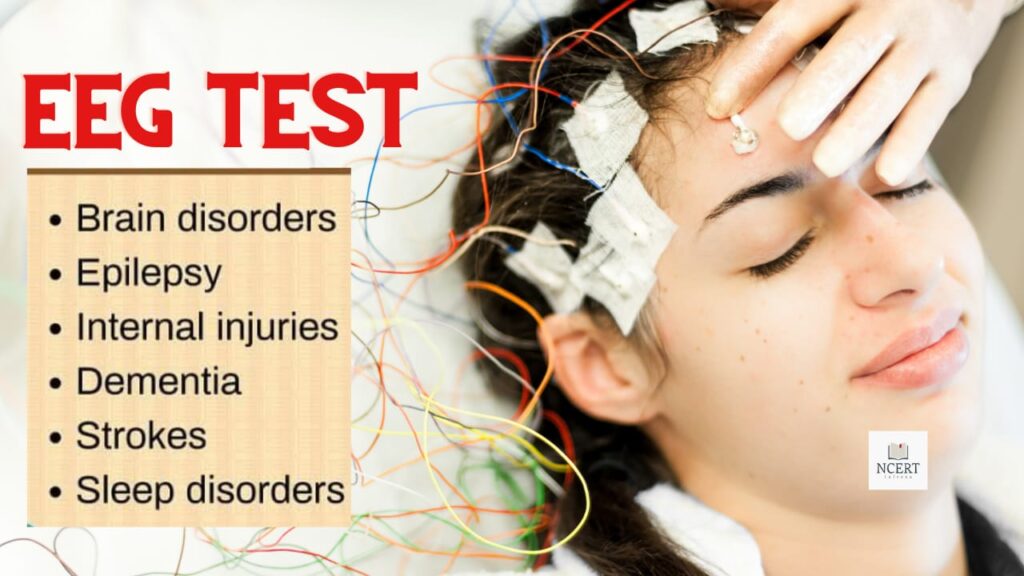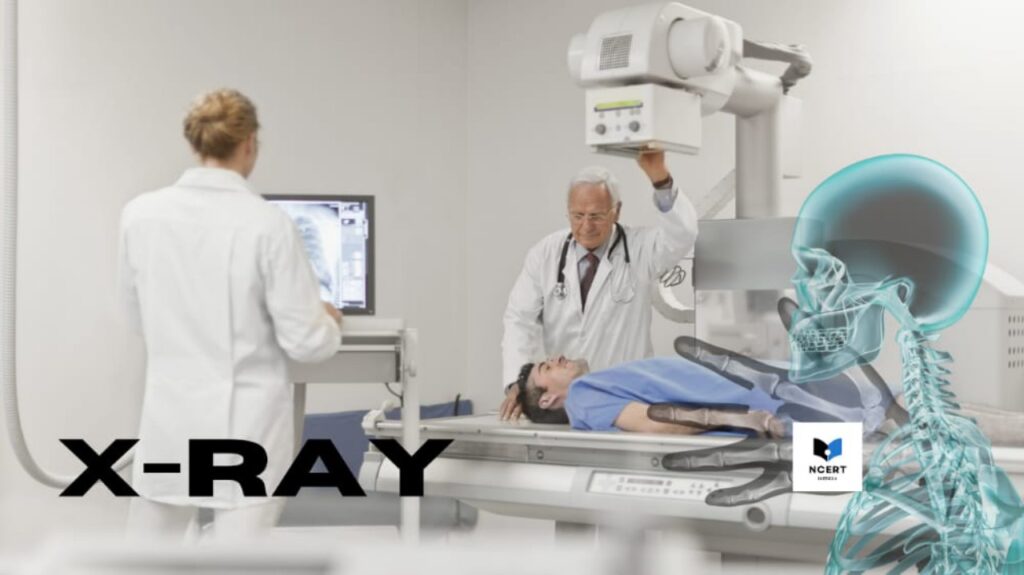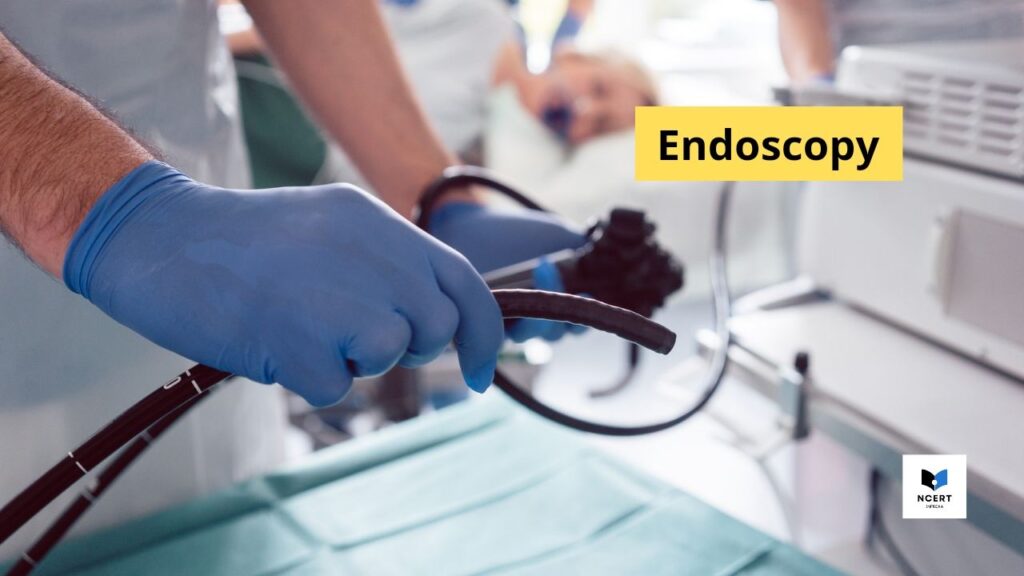EEG Test: Brain wave patterns are monitored and recorded by an EEG machine. There are small flat discs made of metal that is attached to a wire, called electrodes, which are glued to the scalp.
Electrodes analyze electrical impulses in the brain and send them as signals to the computer, these signals are recorded by the computer.
Full form of EEG
EEG stands for electroencephalogram. It is a machine that records the pattern of electrical activity in the brain.
What is EEG Test
An EEG or electroencephalogram test is a recording of brain activity. EEG monitors and records brain wave patterns.
Several small metal discs (electrodes) attached to thin wires are attached to the scalp, which transmits the movement of electrical impulses to the computer in the form of signals.
Normal electrical activity in the brain creates recognizable patterns. EEG recordings show lines of electrical impulses in the brain as valleys and peaks.
With the help of these lines, doctors can quickly find out whether the brain pattern is normal or abnormal.
Any irregularity in the pattern can indicate seizures and other neurological disorders.
Why it is done
- EEG tests are used to evaluate certain types of brain disorders. When epilepsy occurs, the EEG lines fluctuate rapidly due to seizure movements.
- People who have wounds in the brain or any other problem like a tumor or stroke in the brain have a low EEG wave. The fluctuations in EEG lines depend on the size and severity of the brain lesion.
- This test is also used to test for other disorders that affect brain activity, such as Alzheimer’s disease, certain types of psychoses, and a sleep disorder called narcolepsy.
- EEG can also be used to determine the overall electrical activity of the brain, (for example to evaluate brain trauma, drug intoxication, and brain injury in coma patients, etc.)
- EEG may also be used to monitor blood flow to the brain during a surgical procedure.
The death of a patient in a persistent coma an EEG test is also done to confirm.
A continuous EEG also helps in selecting the right level of anesthesia (drug sedation) to put the patient in a medical coma during a medical procedure.
Before EEG Test
If you are taking any kind of medicines, herbal products, or supplements, then tell the doctor about them before getting the test done.
Wash your scalp thoroughly the night before the test. Do not use conditioner or styling products on your hair.
Because hair products can make it difficult for the electrodes to stick to the head, these electrodes record electrical impulses from the brain.
Do not consume caffeine (tea, coffee, etc.) on the day the test is to be performed, as caffeine products can affect the test results.
Keep taking your usual medicines until instructed. If you want to sleep during your EEG test, talk to your doctor beforehand. Because your doctor may tell you to sleep less or stay awake all night that night.
During EEG Test
You may not feel any discomfort or feel very little discomfort during the EEG test procedure.
Electrodes placed on the scalp do not transmit any sensation, they only record brain waves.
During the Test:
- A technician will measure your head and then with a special pencil make some marks on your head where the electrodes are affixed. These marks can be cleaned with a cream to improve the quality of the recording.
- Technicians apply electrodes to the scalp using a special adhesive. Sometimes an elastic cap can be worn instead, in which the electrodes are fitted. These electrodes are connected by wire to a device that amplifies brain waves and records them into a computer.
- It takes about 60 minutes for the EEG test to complete after the electrodes are attached. If you want to sleep during the test, it may take more than 3 hours for the test to complete.
- Sometimes, the technician may ask you to open and close your eyes, do some simple calculations, read a paragraph, look at a picture, breathe deeply for a few minutes, or look at a flashing light.
After EEG Test
After the EEG process is complete, technicians remove the electrodes and wash off the material with which they were attached.
Do not drive home on your own if you are actively having seizures or if your doctor forbids you. If the ECG is done at night, it is better to have someone help you go home.
In case, if no sedative medication has been given during the EEG procedure, then after this procedure no side effects are felt and you can go about your daily activities.
However, if any type of sedative drug has been used during the EEG procedure, it may take some time for this medicine to take effect.
You can resume any medicines you stopped taking for the EEG test after the test.
Once the test is finally done, Specialist doctors of the brain, called neurologists, examine your brain recording patterns.
What are the risks of this Test?
The EEG test procedure has been used for many years and is considered a safe procedure.
These electrodes only record movements and do not produce any sensation. In addition, there are no risks associated with an electric shock.
However, in very rare cases, an EEG can cause seizures in a person (who has a seizure disorder).
In some cases, seeing flashing lights or taking deep breaths can cause seizure problems. If you have a stroke during the test, your doctor will treat you immediately.
If you are concerned about anything related to the test, discuss it with your doctor in advance.
What do EEG Test results mean
The EEG test is performed by a technician, then a doctor who specializes in the EEG interprets the recording.
The recording results are sent to the doctor who ordered the EEG. The doctor may call you at a specific time to discuss the result.
EGG records brain waves from multiple locations in the brain. The neurologist creates separate screens on the monitor for each area of the brain to interpret it.
When neurologists do tests, they look for patterns that indicate problems with a particular area of the brain.
In some types of seizures, for example, there are patterns of specific types of brain waves, which neurologists are trained to identify.
Similarly, the normal brain also has a specific type of brain wave, which neurologists are trained to identify.
A neurologist should look at all the tracings recorded and decide what is normal and what is not. Along with this, it should also be determined what abnormal tracing is showing.
Reasons for abnormal EEG results can be:
- Epilepsy or other seizure disorders,
- Abnormal bleeding or hemorrhage,
- Sleep disorders
- Encephalitis (inflammation of the brain)
- Tumor
- Migraine (headache)
- Drug or alcohol addiction
- Head injury, etc.
Complications and duration of an EEG can vary, with results usually within a day or two.
When to get EEG Test done
The doctor may ask you to have an EEG test in the following circumstances if:
- doctors think you have epilepsy.
- you have epilepsy and your doctor wants more information.
- the doctor is not sure whether you are having these seizures due to epilepsy or some other disorder.
- your doctor is considering epilepsy surgery for you.
- they want to find better medicine for epilepsy.
Changes in brain activity are determined with the help of an EEG procedure, which is very helpful in testing for neurological disorders.
The brain’s intelligence cannot be measured in an EEG test, nor can it detect mental illness.
EEG can be very helpful in diagnosing and treating the following disorders:
- Epilepsy and other seizure disorders,
- Brain tumor,
- Brain injury
- Neurological diseases can have many causes, such as encephalopathy,
- Brain swelling
- Stroke,
- Sleep disorders,
- Dementia, etc.




